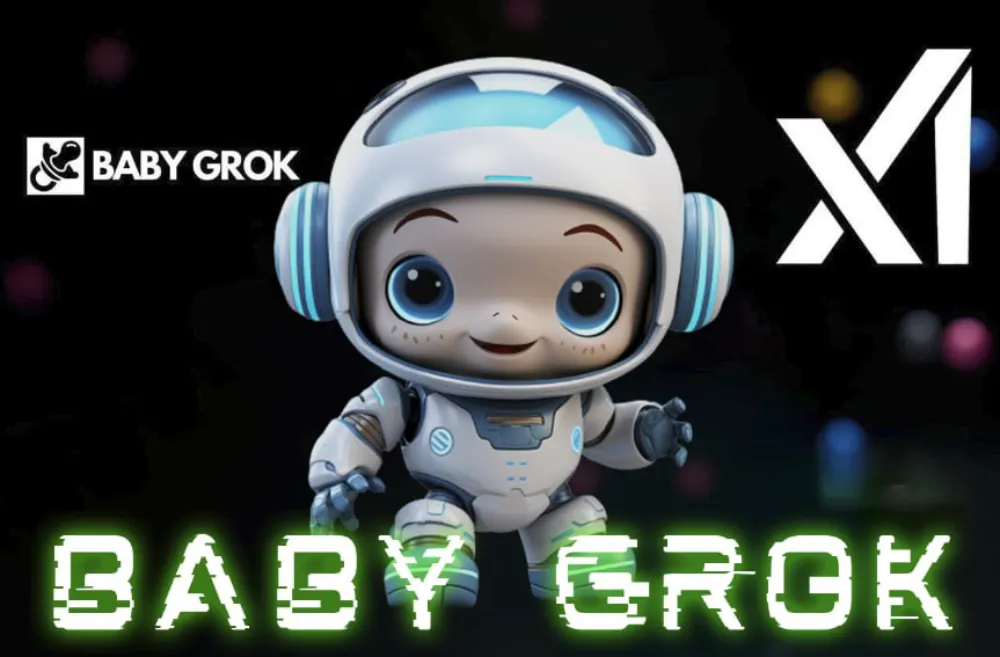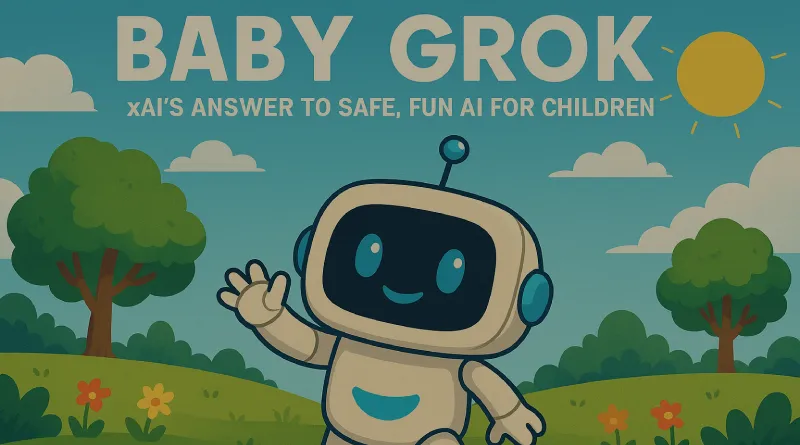Baby Grok: xAI’s Answer to Safe, Fun AI for Children
Elon Musk’s xAI is about to release Baby Grok, an AI chatbot for kids that will give them safe, informative, and fun content. On July 20, 2025, X announced this separate software, which is meant to be a family-friendly alternative to Grok’s adult-themed avatars, which have been in the news recently. This article goes into detail about Baby Grok’s possible characteristics, how it could affect kid safety in AI, and how it could be useful for India’s digital-native families. It gives new ideas and useful information.
Understanding Baby Grok
Baby Grok is a child-friendly variation of xAI Grok chatbot and released in 2023 to challenge ChatGPT and Google search project Gemini. As Musk stated on X post, we are going to create Baby Grok @xAI which is an application providing kid-friendly contents. This caused the impression that there will be an easier interface that resembles the Baby Groot found in Marvel Universe, Guardian of the Galaxy. Baby Grok is going to be age-appropriate responses, storytelling, and educational banter; Content moderation will be moderated to ensure all parties are safe. This contrasts with the more powerful features of Grok such as DeepSearch, or PhD level reasoning of Grok 4.
This is in response to complaints by people on the 3D animated friends of Grok and in particular, his friend, Ani who was criticized as behaving improperly even in the so called kids mode. Baby Grok will solve these issues by ensuring that kids have a secure place to go that lacks any adult content and is parentally controlled to ensure that a family can feel safe.
The Need for Kid-Friendly AI
Since AI is already becoming a part of any field of life, Gartner predicts that 3 billion users will use chatbots by 2026, and children are getting acquainted with digital tools. However, in most cases general-purpose chatbots are not vetted sufficiently, thus introducing the prospect of harm, by having content that is unsuitable. In a report by a media group Common Sense in 2025, 62 percent of all the parents in the world expressed fear that the use of the AI to keep children busy will expose them to content that is inappropriate. Baby Grok may fill this vacuum, and it promises to offer credible assurances to children to learn AI-powered education, such as a math description and daily adventures.
Such comments by X users include, Thank you to Cheerios for cooling me down. I could see that my daughter was wanting to play it but I was not able to permit her to do so, which is the need of the parent to have safe Artificial Intelligence tools. Rather than talking about the sole purpose of entertainment, Baby Grok has any chance of triumphing over the new kids on the block, such as the child-focused version of Google, the Gemini, that adores privacy and ad-free zones.

India’s Digital Landscape: Why Baby Grok Fits
India is a strategic market as it has 450 million children and a fast emerging digital world that makes it a promising market to Baby Grok. Due to 90 percent of the urban Indian homes owning smart phones (as mentioned in a report by IAMAI in 2025), children are getting an earlier contact with technology than ever. However, the safety in the online environment is a question which is claimed by 73 per cent of Indian parents on the revelation of cyberbullying or exposure to content, as found out in a Mcafee survey in 2024. The promises of a regulated, learning platform of Baby Grok may also solve these concerns to the Urban, tech-savvy families who can afford the platform like Mumbai and Hyderabad.
The edtech market in India, estimated at 5.8 billion dollars by 2025, is already flooded with products such as BYJU and Unacademy, and not many of those cater to AI-based learning among young children. Baby Grok could distinguish itself with interactive lesson-related content, like quizzes on Indian geography, science experiments, and so on, and align to CBSE or state boards syllabus. India has 70 per cent of students in rural schools, and they would be the beneficiaries too, provided the xAI guarantees offline mode, which is a problem with tier-2 and tier-3 cities.
Unique Insights: Balancing Innovation and Responsibility
Baby Grok’s announcement raises critical questions about AI’s role in children’s lives:
- Interactive Learning Potential: Unlike apps or various programs, Baby Grok can adjust to the rate at which a child learns and AI would facilitate complex issues to be simplified. As an example, some learners in India, where the culture of stories is a part of daily life, may be interested in photosynthesis being explained to them in a story of a plant that talks.
- Safety First: The debate surrounding the companionship of Grok also means that strict content filters should be developed. According to the DPDPA 2023 of India, xAI should not collect any data in ways that may undermine privacy standards. It could be that transparent safety reports can be a competitive edge of Baby Grok.
- Parental Involvement: Features such as usage reports or shared learning mode would attract Indian parents, who regard active participation in education as the priority. This may resemble such a successful example as parent dashboards in Khan Academy.
- Chance of Overreach: Whereas informative, Baby Grok should not be reactionary, and it has to be extremely prescribed as prejudges, which occurred to Grok when it responded to political questions as Musk. Credibility will be essential and it will depend on factually-based, neutral content.
How Families Can Prepare
Parents can get ready for Baby Grok with these steps:
- Keep Updated: Visit xAI site or X to find out more about Baby Grok launching and capabilities.
- Teach Digital Literacy: Train children to remain safe using AI with the emphasis that Baby Grok is a learning tool, not an unmonitored chat-room.
- Safety Features: When this becomes available, test parental controls in order to specify time constraints and content restriction.
- Companion to Learning: Integrate Learning Take Baby Grok along as the homework, or work on creative assignments, such as story-telling, to enrich school work.
Looking Forward: A New Frontier for AI
Baby Grok is a major advancement as far as xAI is concerned in that it aligns with the objective of the company in providing people with the ability to learn new things besides managing the ethical issues. xAI is expanding, with its value already hitting a sum of 200 billion dollars; Baby Grok might redefine how the children learn. As per a 2025 EdTech India survey, a large majority of parents (80 percent) in India prioritize education. To achieve that it must be affordable, accessible physically and culturally. To stay ahead of the field, xAI must come up with new concepts similar to what Google is doing by entering the kid friendly AI market.
Conclusion: A Bright Future for Young Learners
Baby Grok is a good indication that in future AI will be safer and more educative in relation to kids. Combining addressing historical issues and prioritizing kid-friendly material, xAI is prepared to assist children in learning not only in the Western world but also in the crowded Indian digital scene. Baby Grok may turn to be an attained confidant to the interested kids, as it awaits its time to get out of the stores. This is a blend of entertainment, education and safety that both the parents and the children are going to love.
Disclaimer
The information presented in this blog is derived from publicly available sources for general use, including any cited references. While we strive to mention credible sources whenever possible, Web Techneeq – Top Web Development Company in Mumbai does not guarantee the accuracy of the information provided in any way. This article is intended solely for general informational purposes. It should be understood that it does not constitute legal advice and does not aim to serve as such. If any individual(s) make decisions based on the information in this article without verifying the facts, we explicitly reject any liability that may arise as a result. We recommend that readers seek separate guidance regarding any specific information provided here.

